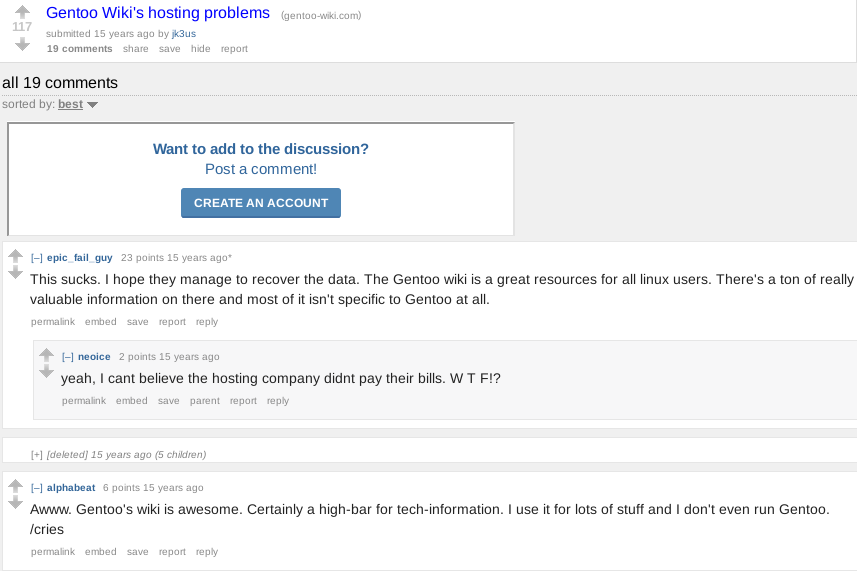For example, I’m using Debian, and I think we could learn a thing or two from Mint about how to make it “friendlier” for new users. I often see Mint recommended to new users, but rarely Debian, which has a goal to be “the universal operating system”.
I also think we could learn website design from… looks at notes …everyone else.

Every distro could learn from Arch Wiki

Even Arch Linux could learn from the Arch Wiki.

The Debian Wiki would actually like a word.
There is stuff in there that’s not found anywhere else. For example while researching driverless printing recently I found a huge page on the Debian Wiki but the Arch wiki only has a paragraph saying supporting printers should be detected automatically.

The Debian wiki is awsome. But it’s less noob friendly than Arch wiki.
The web UI looks like an old forum from 2000. Don’t get me wrong, a well written manpage style webpage is way better than an eye candy bloated scripted webpage (IMO) and I really like how detailed the Debian wiki is. But in today’s “mental standards”, the Debian wiki is not attractive enough for most new comer.
Also, It seems the Debian wiki is not as indexed as Arch wiki on the web.
Finally… I can’t access their wiki with my VPN ! :/.
But I do agree, The Debian wiki is a gold mine !!!

Who made the Arch Wiki? Was it done by the community? Genuine question.

Yup.

The one thing I wish every distro would incorporate is the way Gentoo handles config file updates. If there are any changes you get the option of using a very simple side by side merge where you go through all the differences of the old and new configuration where you can decide which one to use going forward.

While you will get somewhat the same from apt, I like the Debian way of providing base config support in packages and have local config loaded by include statements.
As you don’t edit the default config and automatic updates can happen w/o user input and your config will stay safe

That’s the way it should be. But it depends on the software.

Pacman just dumps you a .pacnew, leaving the comparison to you (y’know, KISS). Your change isn’t touched, unless it’s .pacsave.

Fedora, NixOS and Void need a proper wiki like Arch
Most distros could also learn from Arch and create something similar to the AUR. Nix is going in the right direction.
And I guess almost all distros could learn from Artix and Devuan and reconsider if systemd is the right choice.

NixOS is at least starting to work on a new wiki. The old one is gone and is only accessible from archive.org.

That’s great

Seconded. NixOS’s documentation has consistently been the worst I’ve read, always forcing me to go to the source code to try and understand what in the world is happening. It makes quick changes to new things nigh impossible. I had to resort to taking notes when I understood things about nix in order to retain the knowledge or at least link to where I could easily regain it.
The nixos wiki was marginally better and https://nixlang.wiki/ has been better. However the latter is less known so has less content. All in all, nix documentation is still bad.
Anti Commercial AI thingy

NixOS has the best concept and even pioneered it, but whether its implementation and documentation is perfect is a topic for debate.
However, it’s been quite long since I had to fiddle with my config and as such, the downsides don’t really affect one on a daily basis. In fact, I recently reinstalled my machine to change the root filesystem and it was an absolute breeze. If not for secure boot, it would have been absolutely trivial, and with secure boot it was easy and convenient.
As such, I consider the pains an investment into system that runs much better down the road. Though I’d love it if these pains were reduced.

NixOS has the best concept AMD even pioneered it,
I’m assuming “AMD” is a typo?
Anti Commercial AI thingy

Yes! Apologies, didn’t proofread what my phone produced from swiping

It would’ve been welcome and surprising news! 😄
Anti Commercial AI thingy

I’ll definitely check that out, thanks

The Debian Wiki is so much better than the Arch one.

Absolutely not

Not approachable at all.

This has to be bait.

It is not

Most distros could also learn from Arch and create something similar to the AUR.
i’ve seen Void’s
xbps-srctool compared to the AUR multiple times in /r/voidlinux (and i guess it’s like a decentralized AUR?? you can build+install pkgs from source using the package manager, sure, but there’s no one big diy xbps packages registry like aur.archlinux.org for Void) and while i don’t really see it, if you follow that train of thought, void’s pretty set in the “right direction” :D
I heard about it, but haven’t tried it out properly yet.

Just installed Debian today. Jesus the site/wiki is ugly

What’s wrong with it?

I mean… Gestures vaguely


You probably shouldn’t be accessing a linux distro’s website from mobile but yeah the site does look weird and amateur


You probably shouldn’t be accessing a linux distro’s website from mobile
Well how else am I going to access it, I borked my computer mid-install :P

Yeah, just curl it into aplay like the rest of us, jeez

No excuse for websites that render poorly on mobile nowadays.

You probably shouldn’t be accessing a linux distro’s website from mobile
I don’t think it’s good to hand-wave a website’s poor user experience and instead blame the user’s device. The fact of the matter is that Debian’s website is not as responsive as it could (imo, should) be and results in a bad user experience. With mobile traffic being responsible for over 55% of the internet’s traffic, it can be generally assumed a user’s first experience learning about a distro will be on a mobile device. If that first impression is bad, that can spell bad news for that distro’s adoption/onboarding.

What do you mean, I’m a web dev and that looks completely normal.

Its missing tons of images, CSS and unnecessary frameworks. So no, it is not normal
For me it’s mostly that the site sprawls in unintuitive ways. It’s possible to have a simple look while being easy to navigate, for example (and this is subjective, but still) https://www.openbsd.org/

I miss when this style of website was more popular for software projects. There are plenty of projects with modern websites that still manage to do it well, but there’s just something about the instant familiarity that comes with that type of layout.
I know what you mean, I remember when debians website was like this: https://web.archive.org/web/20021122032757/http://www.debian.org/
Is it just a generation thing, or is it objectively easiler to navigate?

Sorry if my irony wasn’t too obvious. It certainly is not supposed to look that way. There are a lot of pages all over the internet that function just as garbage as this, especially on mobile. That’s why I meant it looks “normal” as in not out of the ordinary.

I think more distros should have an easy way to set up disk level encryption in the installation

And know how to use an existing btrfs partition. And always [at least have an option to] show exactly what the automatic installer is going to do before I run anything. There’s gotta be a middle ground between “we’ll just surprise you” and “here, do everything yourself”.

OpenSUSE has a guided setup if you dont want a surprise or don’t know what manual setups requires. then prior to starting givea you a summary of what will be done.

Great, there we go, sounds like all distros should learn from OpenSUSE.

Each one has good parts, but I think openSUSE did a lot to make things easier for new users to linux
- Install, you see software summary, you can click and alter what patterns or packages you want included.
- auto snapshots when you enter package manager or admin tools, easy rollback with snapper or boot list
- a GTK front for all of YAST2-GUI components. All system, network, firewall, service, packages, boot and kernel config are available as GUI dialogs (as well as many others)

Gentoo - patience.
But seriously. With theUSEflags, compiler options, you can understand software more from a developer’s point of view.
You can try to optimize software for your hardware.
Fully explore theconfigureoptions. With a binary package you have no control.
I think with Linux Mint the main User Friendly thing is its DE. But with Debian you can install Cinnamon DE as well. https://packages.debian.org/search?keywords=cinnamon
btw, I quite like the Debian website, colors and design.

I am sure you are aware of this: https://linuxmint.com/download_lmde.php

Yes. Nice that there is the Debian choice. And nice that Linux Mint refrains from using Snaps by default like Ubuntu.

The Debian web site needs a good UX overhaul. Prioritize the things people are most likely to want, make them prominent and uncluttered, and present a logical flow from one task to its follow-ups.
Just a quick glance yields the simplest example: the download link is not the first or most prominent thing on the main page. Clicking “download” gives you the netinst AMD64 ISO, which is reasonable enough, but there is no indication of how to install it. Clicking “user support” takes me to a page with extremely verbose descriptions of IRC, usenet groups, and mailing lists. I think the fastest way to get installation instructions is to click the tiny “other downloads” link (after I’ve already downloaded the one I want!), and then a link to the manual from there.
This is not a good UX. This is a demographic filter. You can argue that’s appropriate for a technically-oriented OS. 9front explicitly makes itself unapproachable to dissuade casual users, but I think Debian can and should be more appealing to mainstream, casual newcomers.

The Debian web site needs a good UX overhaul. This is not a good UX. This is a demographic filter. You can argue that’s appropriate for a technically-oriented OS. 9front explicitly makes itself unapproachable to dissuade casual users, but I think Debian can and should be more appealing to mainstream, casual newcomers.
Your opinion, fine. So why do you want Debian to have more mainstream users ?

Why not? It’s a great general-purpose distro.
My point is that 9front’s user-unfriendliness is a feature (explicitly intended), whereas I think Debian’s is a bug (not intended or desired). I’m not psychic, though, so I could be wrong about the Debian team’s goals.

Why not? It’s a great general-purpose distro.
My point is that 9front’s user-unfriendliness is a feature (explicitly intended), whereas I think Debian’s is a bug (not intended or desired). I’m not psychic, though, so I could be wrong about the Debian team’s goals.
As far as I am concerned Ubuntu has since around 2004 already helped a great deal with getting more mainstream Linux users on board. With the new Debian stable release of Bookworm for the very first time non-free firmware came with the installation media and that could be useful for lots of people, but still I will not recommend Debian for people interested in Linux. I will tell usually them to go for Linux Mint or Ubuntu.
Here an example of what I think could do better website design (Not Linux but zsh) : https://www.zsh.org/ And this is also not too appealing to get more mainstream Linux users on board : http://www.slackware.com/ (One of the first Linux distributions. No SSL, but the site seems pretty functional).
Here an example of what I think can appeal to a lot of mainstream : https://bazzite.gg/ That may attract quite some people (though I personally do not like such site design at all) to use Linux.
Then again, people are different. I find the Arch wiki a fantastic resource. Today in a comment on Lemmy someone wrote that it is horrible.

I mostly agree. I usually recommend Mint to new users, largely because their web site and defaults are very beginner-friendly. Mint is the modern version of what Ubuntu used to be 10-15 years ago. At this point I don’t think Ubuntu has tangible advantages over Debian for new users.
I really like Slackware’s site. It’s not sexy, but it’s functional, organized, and easy to navigate. The Zsh site is counterintuitive to me with that sidebar-that’s-not-really-a-sidebar, and hyperlinks whose text requires the context of a header that is not aligned with them.
I just checked out Ubuntu’s web site for comparison, and…uh…now I feel like I owe Debian’s web site an apology. I guess the consumer desktop Ubuntu distro doesn’t actually have its own web site anymore? I mean, you can get to it from there, but it’s hidden under menus, and seems almost like an afterthought. Ubuntu’s main web site is bizarre right now, with a prominent green “Download Now” button that does not lead the user anywhere close to downloading Ubuntu, but rather directs them to one of a rotating selection of signup forms to download various technical whitepapers like “A CTO’s guide to real-time Linux”. That’s a radically different target audience than the last time I went to their web site (and also a weird design anyway).

I just checked out Ubuntu’s web site for comparison, and…uh…now I feel like I owe Debian’s web site an apology. I guess the consumer desktop Ubuntu distro doesn’t actually have its own web site anymore? I mean, you can get to it from there, but it’s hidden under menus, and seems almost like an afterthought. Ubuntu’s main web site is bizarre right now, with a prominent green “Download Now” button that does not lead the user anywhere close to downloading Ubuntu, but rather directs them to one of a rotating selection of signup forms to download various technical whitepapers like “A CTO’s guide to real-time Linux”. That’s a radically different target audience than the last time I went to their web site (and also a weird design anyway).
I guess this has to do with the fact that BDFL Mark Shuttleworth after putting so much money into Ubuntu finally wanted to see some profit (I think I read that Ubuntu was not profitable for a long time) and went in the same direction like RedHat Enterprise and Novell SUSE had been going. If you look at Canonical Juju https://en.wikipedia.org/wiki/Juju_(software) launched 12 years ago, and things like Landscape https://ubuntu.com/landscape which has been there perhaps more than 10 years as well, and now with Ubuntu Pro it seems clear to me that Ubuntu was not just meant to be a desktop Linux distribution. In fact, nowadays when I try to find an iso file for an Ubuntu installation I need to be careful not to end up at a download page for the Ubuntu server iso.
Anyway, maybe I should instead try out and be recommending Pop! OS to new Linux users soon. It seems very popular https://pop.system76.com/ ;-)

Slackware - if it ain’t broken don’t fix it. Gentoo - USE flags. Mint - user-friendly.

Slackware needs to learn how to be hip like arch. I’m the baby in our irc group, and I’m 40. All the cool kids are using arch BTW.

Never cared much about trends.

It’s nice to find another slacker in the wild.

Fedora Atomic Desktop, mainly KDE.
- Fedora adds their pretty useless Fedora Flatpak repo, that is more secure but has unofficial packages, an additional runtime in RAM and a very small set of apps (they need it due to “legal problems” when preinstalling apps. Like… just dont preinstall them but add a startup page to install them manually?)
- There is no good way to use NVIDIA as it needs proprietary drivers and some tweaks. Ublue fixes that. Same with other out-of-tree stuff. Not really their fault, but be aware that atomic Fedora has basically no proprietary NVIDIA driver support.
- i think their kernel is extremely bloated, I would prefer having separate ones for only intel, amd, nouveau and also removing all the legacy hardware drivers nobody uses
- an x86_64-v4 (or at least v3) variant would be really necessary (my 2012 Thinkpad is v3)
- they will likely prefer to use flatpak firefox, just like ublue does, ignoring the inability to sandbox processes at all. This is the list of issues that need solving until Firefox “can be shipped as flatpak”
- they use toolbx (with that silly rename from “toolbox”) instead of distrobox. Distrobox has way more critical features like a separate home, which prevents breakages through conflicting dotfiles. Toolbx is the worse product.
Also, their traditional KDE variant is very bloated, which is why I updated this guide
But overall its still my favourite distro. Has a nice community, all the desktops you want, SELinux (which is btw required to make Waydroid somewhat secure) and their atomic stuff is an awesome base thanks to ublue.

You mention that their kernel is bloated, would you mind sharing how you measure it compared to other kernels. Such as their kernel vs something more trimmed down. Is it a storage space savings or memory? I’ve never really considered the weight of a kernel when considering different distros so if you have some method I’d love to try and compare what I’m running.

I have no comparisons as I think all distros ship the complete monolithic kernel. Of course specific IOT devices or Android ship a very much smaller kernel.
Building the kernel is not that hard, as you have
kernel-develwhich has all the sources.You can use
make menuconfigand see what all is enabled (as far as I understood this) and change stuff before compiling.Monolithic kernels are pretty bad, see this excerpt of the interview with Jeremy Soller on RedoxOS.
So I dont mind memory or even less storage space, as the kernel poorly is not relevant at all here. I just care about keeping the root binary with access to all my stuff as small as possible.
I would love a system that detects the used hardware and then builds the correct small kernel for it. There are experiments making the CentOS LTS kernel work on Fedora, which would prevent many recompilations.

Building the kernel is not that hard, as you have
kernel-develwhich has all the sources.Yeah. Some myth that it’s hard to do is not why we end up with monolithic kernels. Like any case where you find yourself thinking “it doesn’t look that hard; I could do that easily”, it’s either harder than it looks or it’s done a certain way for an entirely different reason you haven’t figured out.
You should learn that reason.

There are many steps that need to be followed, I didnt have the time yet but it is possible. You need to sign the modules and kernel, package as an RPM, sign that maybe etc. Its not as easy if you do it right but also not very hard.

If you don’t mind me asking, then how do you know the kernel they use is bloated compared to any other kernel? A vast majority of the device-list stuff is loaded only when that device is detected with kernel modules. You aren’t actually running everything from the entire kernel, it just has support for the devices if it does detect them. which is basically the functionality you are asking for, ad-hoc device modules.
Monolithic kernels aren’t “bad”. That’s subjective. Monolithic kernels have measurable and significant performance benefits, over micro kernels. You also gain a massive complexity reduction. Micro kernels, historically, have not been very successful, e.g. Hurd, because that complexity management is extremely difficult. Not impossible, but so far kernel development has favored monolithic kernels not without reason.
If what you say is actually that easy, why wouldn’t all distro’s just do that during the install, and during updates with their package managers? I believe you could do this in Gentoo, but I don’t know if it has measurable benefits beyond what performance tuning for your specific CPU arch would give you. Since none of those devices you aren’t running are consuming any resources beyond the storage space of the kernel.

“Their kernel is bloated” :D I dont compare with anything, as a linux distros job is pretty much to make me forget other ways to get “the linux stuff” because they are so good.
(Imagine how good Linux support would be if everyone would be on the same distro family like Fedora rawhide/stable/oldstable/centos-stream/almalinux;rockylinux;rhel.)
it just has support for the devices if it does detect them. which is basically the functionality you are asking for, ad-hoc device modules.
If that is true, and if the kernel will never load anything not needed for my device, then I am fine with it.
I see how monolithic is less complex and also a huge performance benefit over having the handshake between userspace and kernel space all the time (a meta dev on #techovertea talked about that).
But I would still want to debloat the kernel from unused code, as it is there somewhere and may get activated and used (why would you blocklist kernel modules otherwise?)
Also compiling for x86_64-v4 would probably improve speed, and it is rediculous to have the entire distro built for 20 years old hardware, neglecting all the improvements from over a decade.

It wouldn’t be too difficult™ to fork their kernel and make custom configs of it. Here’s the git repo that holds their rpms and their respective kernel configs, it’s just that nobody has cared enough to create/propose “slimmed down” specialized kernel images: https://src.fedoraproject.org/rpms/kernel/tree/rawhide You can just clone the repo and point COPR to it, then automatically build custom kernels.
Awhile ago there was a proposal to move the x86 microarchitecture level. Here’s recent discussion on that proposal: https://discussion.fedoraproject.org/t/what-happened-to-bumping-the-minimum-supported-architecture-from-x86-64-to-x86-64-v2/96787/2
In general, though, Fedora would not want to leave any users behind. Instead, the proposal for
hwcapsis currently being drafted: https://pagure.io/fesco/issue/3151 With hwcaps, default installs will be x86_64 v1, but will be upgraded to “optimized” packages if available upon updating. This makes packaging a bit awkward, though. Packagers already need to maintain packages for multiple versions of the distro. In fact, they need to support F38, F39, F40, and rawhide atm. Needing to maintain an extra 3 builds for each package on top of x86, x64, aarch64, ppc64le, and s390x is a bit of a burden, so success might be limited.Distrobox, while feature-rich, is still a bit hacky (though it’s still more reliable in my experience than toolbx). You’re not the first to want this, though: https://github.com/fedora-silverblue/issue-tracker/issues/440

Secureblue removes a good amount of unused kernel component, and even some useful ones like bluetooth and thunderbolts, but you can always manually enable them.

Yes thar is the direction I am going to. But they just disable kernel modules from running, I dont know if that is as complete as simply not building them.
But if its possible, then everyone with amd or intel should block nouveau, and vice versa. Just keep it small.

Yeah, this is the old philosophy of the “run anywhere” philosophy of linux (or computers in general) that got us here. Another problem with stripping down kernel drivers is that swapping hardware component will require rebuilding the kernel, which regular user will definitely not be happy about.

It would be a problem because of how it is currently done.
I imagine an install ISO to have a monokernel, build the kernel-building-system and detect the needed drivers. Save the config and build the matching kernel from that.
Now if you want to swap hardware, there is a transition tool within the OS that allows to state the wanted hardware component and remove the old driver from the config.
Or you switch to a monokernel and run the hardware detection and config change again.
Or you use the install USB stick (which you already have) which already uses a monokernel and has a feature to detect hardware, change the config on the OS, build and install the kernel to the OS.
This is a bit more complex than for example what fedora plans with their new WebUI installer. Poorly such a system also doesnt work that well with so many kernel updates.

I am not an expert, but I feel like rebuilding the kernel is probably too slow for most user.
And kernel already dynamically load the kernel module, then disabling them would practically make sure they will not be loaded.
I feel like we don’t need to go down to micro-kernel to solve the problem of loading too many drivers.

What I really like about stuff like RedoxOS, COSMIC, typst, simpleX, Wayland and others is having stuff built from a modern perspective with modern practices.
Linux is ancient now, and its a miracle that it is thriving like this.
If dynamic loading really is that robust, it probably doesnt matter. But I dont know how big the performance increases are and I really need to do benchmarks before and after.
There are btw also some experiments on making tbe CentOS-Stream LTS kernel run on Fedora. Which would be another great way of getting a more stable system.

Debian is so hecking unstable for me omg… For some reason it just doesn’t play well with any hardware setup I’ve ever tried.
Anyways, I use arch Linux which could REALLY do with a nice wiki overhaul by now. It’s not beginner friendly AT ALL! Been using the same install for almost 3 years now I think, but man… When I have to figure out something, the wiki isn’t the first thing I’ll go anymore.
EDIT: Why the downvotes?
If Debian fails in the same predictable way every time, for the same reason, it could be argued that it’s very stable, just not functional :) What kind of hardware do you use by the way?

It fails to run after a few days on several different laptops I’ve tried it on. Also on my main computer which is an amd 3900x with 64gb ram and a 3090. Arch however works perfectly fine, which is odd as heck

Maybe the kernel version on Debian lacks hardware support fixes?

The Arch Linux wiki has been the best source for information for a long time for me. Many years ago the Gentoo wiki was good as well, till they lost all content and had to start from scratch.

I use Debian but still use the Arch wiki quite often. It’s a great resource. I improve Debian’s wiki where I can (eg I wrote a few sections on this page: https://wiki.debian.org/NFSServerSetup) but it’s just not the same.

[…] till they lost all content and had to start from scratch.
What happened? Now you got me curious

Let’s see. 15 years. Hosting company didn’t pay the bills. All gone. No backups.


Downvote because i like the arch wiki very much and it was beginner friendly enough for me, tho (installed arch as a noob recently)
(Well I did not really downvote to be honest, but if I did, that would be the reason)

Hm, weird. I tried following to wiki to fix some Bluetooth issues I had. It didn’t fix my issue and on top of that it’s all over the place.
Man, I feel like some people treat the wiki as a hecking Bible omg…

Hmm… well… I don’t know, I just almost every time find my solution there and generally I just google xxx arch linux using DDGO. 💁🏻♀️ maybe it’s not for every kind of person 🤔

Idk about instability but in my experience Debian always required the highest amount of work to fix and set up (on very different machines) compared to other distros smh

Not my current distro but I love ChimeraLinux, they manage to put musl and BSD userland into a working wonderful distro. I wish more distros adopted musl.

What I am really hoping catches on from Chimera is Turnstile: https://github.com/chimera-linux/turnstile
While I love that Chimera is Wayland only from the start ( no Xorg ), I do hope we get more DE options than just GNOME at some point.
Early days still for Chimera. I expect big things.

Alpine & OpenBSD with CLI installers, minimalism, lack of bloat and strong KISS philosophies, they remind me of what Arch Linux used to be – I don’t want any crapware if possible (dbus, systemd, polkit, logind etc). Just nice and simple.
The only one I have installed is dbus, unless you want to manually patch it out it’s pretty much everywhere (Gentoo is nice for this).

Maybe you would like Void or Chimera

I’ve used Void over half a decade or so, runit is nice, but I think I like the Alpine ecosystem more, plus Void has some oddities to me.
For instance, in the repositories no forks of big projects like Librewolf instead of Firefox, no crytos like Monero, also xbps has both caps and non caps for naming for projects, it’s nice to not have to use caps to install things. I know you can get around most of this with stuff like flatpak :)
I tried Chimera and liked it but again Alpine has a larger ecosystem, it’s more established in that respect both from containers and router/server use.
I’m also pretty used to Alpine’s quirks at this point, I’ve run it a quite a lot on my laptop with a funky DIY ZFS install and also run-from-RAM quite a lot on USBs. Having a stable branch is nice too, although I never really had many problems on Void either!

If you want Debian but user-friendly, just use Mint, Debian is easy enough to install. It’s like asking Gentoo or Arch to drop a easy installer, it would break the point of using it.

Gentoo and Arch do have easy installers (Arch via the Arch install script, Gentoo… Well, they provide stage 3 already built, a genkernel option, and even binary distribution now, which greatly simplifies the process)

Arch install is not official and it’s not that stable, and what’s the point of using Gentoo if you don’t use the main reason to use it ?

Honestly, that one had me scratching my head too, I doubt I’d ever use the precompiled binaries on Gentoo myself
The stage 3 tarballs and genkernel, though, make an install that could take a week or more down to a few hours; having successfully built a system from a stage 1 with customized kernel, that’s not an experience I feel a burning desire to go through again

having successfully built a system from a stage 1 with customized kernel, that’s not an experience I feel a burning desire to go through again
It’s a way to do, and yes it’s not made for everyone. Currently im using vanilla Arch but i understand how great source installed Gentoo is
Would it detract from Debian if it had an installer which was more intuitive to new users? As long as they don’t remove the options to configure, I see no harm, only benefits. To me, the thing about Debian is that it’s a community. If a distro wants to be elitistic, sure, that’s up to them, but I don’t see Debian having that goal.

You could check out Spiral Linux for an “easier” installer. It has the option to use the Calamares installer from the live USB instead of Debian’s default. Also comes preloaded with back port repositories and, I think, Nvidia drivers.
I like that Spiral Linux is “plain” Debian, without extra repos. What I’m thinking is more along the lines of “why is Spiral Linux needed to begin with?” Sometimes downstream distros serve a niche function that warrants its own distribution, but sometimes I feel that if upstream improved, the need wouldn’t be there to begin with.

There’s already an gui installer on Debian, what do you want ? The system to install himself without asking for your preferences ?
I don’t know. It’s difficult for me to answer because I’m so used to the Debian installer. But, for some reason the general opinion is that it’s difficult for many compared to some other distros.

More difficult because Debian rely more on the terminal than mint. The terminal is not a accessorie like on Windows, it’s part of basics Linux uses. In my opinion it’s important to learn how to be familiar with
I think text based interfaces is a strength of unix-like systems, valuable tools to be used when the situation calls for it. It might be a lot to ask of new users to be familiar with terminals before they have even installed the system though. If Mint can get the same result with a GUI, I see no reason why Debian can’t offer that option too, and let users discover bash and TUI when they have a working system.

When you’re beginner it’s normal to not be familiar with terminal, that’s why i recommend Mint as a first distro. What im saying is that We already have Mint as a beginner-friendly distro, we don’t need Debian to be as simple as Mint, also they included non-free firmware in their iso it’s pretty enough imo.

I’d really like it if Fedora didn’t discourage packaging static libs, but still discouraged building packages with static libs. It’d be nice to have them for development purposes.
I also wish they made “third party” software a bit easier to access in their installer and distro as a whole. The option to enable Nvidia drivers is buried, and even though flathub is now unrestricted when toggled in the installer, it’s not the first priority when prompted for software to install in gnome software.
A longer support cycle with less releases would also be nice, but would defeat the purpose of the distro. I guess it’d make more sense if CentOS Stream released more frequently and with more packages available in EPEL, similar to Ubuntu.

I do not recall other distros failing to update due to GPG key issues but it has happened to me on Arch distros many times. It is the biggest pain when converting from something like Manjaro to something like EndeavourOS as well.
I really do not understand why this cannot be fixed.

That’s an Arch issue as far as I can tell
